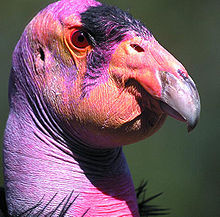This article may require copy editing for grammar, style, cohesion, tone, or spelling. (October 2024) |
This article includes a list of general references, but it lacks sufficient corresponding inline citations. (October 2024) |
| Cathartiformes Temporal range: Eocene to present
| |
|---|---|

| |
| California condor | |
| Scientific classification | |
| Domain: | Eukaryota |
| Kingdom: | Animalia |
| Phylum: | Chordata |
| Class: | Aves |
| Clade: | Accipitrimorphae |
| Order: | Cathartiformes Coues, 1884 |
| Subtaxa | |
The Cathartiformes /kəˈθɑːrtɪfɔːrmiːz/ order of scavenging birds includes the New World vultures and the now-extinct Teratornithidae.[1] Unlike many Old World vultures, this group of birds lack talons and musculature in their feet suitable to seize prey. In the past, they were considered to be a sister group to the storks of the order Ciconiiformes based on DNA–DNA hybridization and morphology.[2][3] However, a 2021 analysis of mitochondrial genes suggested a stronger phylogenetic relationship between Cathartiformes and subfamilies of Accipitriformes.[4]
- ^ Chatterjee, Sankar; Templin, R. Jack Jr.; Campbell, Kenneth E. (July 24, 2007). "The aerodynamics of Argentavis, the world's largest flying bird from the Miocene of Argentina". Proceedings of the National Academy of Sciences. 104 (30): 12398–12403. doi:10.1073/pnas.0702040104. PMC 1906724. PMID 17609382.[failed verification]
- ^ Ligon, J. David (1967). "Relationships of the cathartid vultures". Occasional Papers of the Museum of Zoology, University of Michigan (651). hdl:2027.42/57087.
- ^ Sibley, Charles Gald & Ahlquist, Jon Edward (1990): Phylogeny and classification of birds. Yale University Press, New Haven, Conn.
- ^ Urantowka, Kroczak, Strzała, Zaniewicz, Kurkowski, Mackiewicz, Adam, Aleksandra, Tomasz, Grzegorz, Marcin, Paweł (August 15, 2021). "Mitogenomes of Accipitriformes and Cathartiformes Were Subjected to Ancestral and Recent Duplications Followed by Gradual Degeneration". Genome Biology and Evolution. 13 (9). doi:10.1093/gbe/evab193. PMC 8435663. PMID 34432018.
{{cite journal}}: CS1 maint: multiple names: authors list (link)